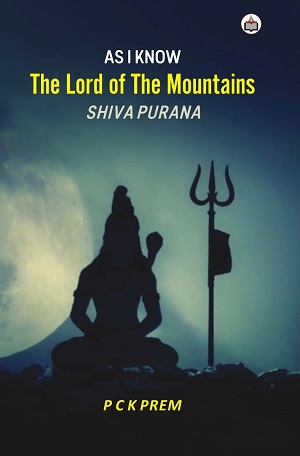Oct 15, 2025
Oct 15, 2025
by P C K Prem
As I Know: The Lord of the Mountains — Shiv Purana: 07
Monks ask about the means to get rid of pasas (sins, human bondages) at Prayaga, a holy place where they hold a great yajna …and to attain the great lord one also learns that listening, singing of hymns in praise of lord Shiva and deliberation on the great lord lead to moksa
 Initially, Suta tries to dispel fears causing anxieties in the minds of sages and thereafter, he speaks about the glory and grandeur of Shivapurana. The monks are conscious of the human bonds and consequent sufferings these entail, and therefore, want to know the path to freedom from worldly attachment. After initial prayers, sage Vyasa speaks about the yajna holy men organise at Prayaga, the confluence of Ganga and Yamuna. At that time, Suta, a disciple of Vyasa, an authority on Puranas arrives. Sages are happy and so to dispel doubts lurking in the minds, they speak about the sins of people of all classes and castes including women, who indulge in spiteful, ferocious and intolerable acts in Kaliyuga and stay away from acts of dharma – truth and righteousness. Sages wish to know about the possible solution to the doubts expressed so that people live life of peace, truth and dharma.
Initially, Suta tries to dispel fears causing anxieties in the minds of sages and thereafter, he speaks about the glory and grandeur of Shivapurana. The monks are conscious of the human bonds and consequent sufferings these entail, and therefore, want to know the path to freedom from worldly attachment. After initial prayers, sage Vyasa speaks about the yajna holy men organise at Prayaga, the confluence of Ganga and Yamuna. At that time, Suta, a disciple of Vyasa, an authority on Puranas arrives. Sages are happy and so to dispel doubts lurking in the minds, they speak about the sins of people of all classes and castes including women, who indulge in spiteful, ferocious and intolerable acts in Kaliyuga and stay away from acts of dharma – truth and righteousness. Sages wish to know about the possible solution to the doubts expressed so that people live life of peace, truth and dharma.
Suta hears genuine anxieties of sages and tries to drive out suspicions he finds relevant. He tells that Shivapurana contains the substance of the Vedas. It chases away sins and helps man to attain Brahma, the highest truth. Shiva destroys sins in the age of Kali and gives reward if one follows principles of dharma, artha, kama and Moksa. Suta dwells on the significance of Samhitas, which are huge in size but he tells that the reading of these books grants the desired fruit to the devotee. Samhitas are – Vidyeswara with ten thousand verses, Rudra, Vinayaka, Uma and Matri Samhitas consist of eight thousand verses, Ekadasharudra has thirteen thousand verses whereas Kailasa Samhita contains six thousand and Shatrudra Samhita consists of three thousand verses. Kotirudra has nine thousand and Sahastra Kotirudra has eleven thousand verses. Vayaviya consists of four thousand verses, and Dharma has twelve thousand and thus, Shivapurana has a hundred thousand verses, which Sage Vyasa reduced to twenty four thousand verses that is roughly one fourth of the whole Purana without impairing the essence.
He, who devotedly reads the holy Samhitas soon attains liberation from the sins of worldly life, for all pasas are destroyed. Therefore, the holy Purana is the destroyer of three-fold catastrophes and tragedies of life relating to the intellect, the physique and the spirit. Purana is a collection of supreme mantras that grant human beings enrichment in dharma, artha and kama and finally, a sadhaka attains the Supreme.
Now, sage Suta on request from Vyasa speaks fluently about the quintessence of theVedas, the great Purana contains. Purana speaks fondly of devotion, wisdom and detachment, which are possible through Vedanta. In the present age, a controversy arises as to which is greater or superior and so sages go to Brahma the cause of all causes to seek exposition of the principles Suta tells. One can realise him – the omniscient, the omnipresent and the lord of the universe only through devotion. All gods including Rudra, Hari, Hara and other can see the lord through bhakti, Brahma tells. Through grace of lord, one can attain the substance of mystical knowledge the Vedas contain. He, who is true and devoted, is blessed with the grace of the Supreme. One attains the fruit based on the quality and standard of prayer, worship and devotion. Deliberation is an excellent path to deliverance.
To listen attentively is must. Intellect leads to deep reflection and so it weighs up the effectiveness of worship and chanting. A hymn is a vivid expression of lord’s different images, shapes, forms and attributes. Sanatkumara tells seriously Vyasa to concentrate on truth, and truth is lord Shiva and thereafter, he speaks about the significance of listening about the glory and splendor of Shiva. He reveals that to sing hymns, to eulogise the great lord and profound deliberation on him are the three means to attain moksa as the Vedas endorse. These are the valuable pearls of wisdom the chief of ganas Nandikeshwara imparts to him and so sage Suta advises brahmins to practice the three means to attain salvation. Sages express some doubts and ask further, “What a man should do, if he cannot practice the above steps – a path to liberation that is without pressure of arduous labors and attain moksa.
Continued to Next Page
07-Aug-2021
More by : P C K Prem